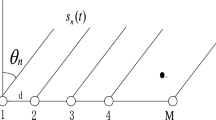Abstract
With the rapid development of information technology, information war is becoming more and more intense. Signal processing plays an increasingly important role in information war, and the application of this technology is becoming more and more extensive. The information signal processed by the traditional frequency hopping communication system is relatively single. When there are a variety of electromagnetic signals, the communication channel environment is complex and there will be signal interference. Therefore, this paper studies the detection, identification, and experimental simulation of quasi-frequency hopping signal under multi-fixed frequency interference. Firstly, this paper uses the short-time Fourier transform and Wigner–Ville time–frequency analysis method to identify and simulate the interference signal of multi-fixed frequency interference. Then, according to the working principle of genetic algorithm, the design steps of radio high frequency (RHF) signal are designed, the signal model is constructed, and the narrowband interference suppression strategy is proposed to suppress the fixed frequency interference signal. According to the simulation of this model in this paper, the suppression effect of time–frequency domain and joint method is more obvious than that of traditional time–frequency domain. If the fixed frequency interference signal only covers a small part or does not cover the quasi random frequency hopping signal, the signal suppression effect of using time–frequency domain to filter the interference signal is better than using non-decimation wavelet packet transform algorithm, and there will be no error impact on the original signal when completely using time–frequency domain to filter the signal. Finally, this paper combines the interference analysis algorithm in time domain and time frequency domain and carries on the simulation analysis. Through the application simulation of multi-target scene, the results show that the complementary code modulation method can estimate the distance and velocity parameters in multi-target scene. Although the velocity measurement range is narrow, this method has the advantages of high velocity measurement accuracy, higher output signal-to-noise ratio and lower computational complexity.





Similar content being viewed by others
Explore related subjects
Discover the latest articles, news and stories from top researchers in related subjects.Data availability
The data used to support the findings of this study are available from the corresponding author upon request.
References
Romaszko S, Denkovski D, Pavlovska V, Gavrilovska L (2012) Asynchronous rendezvous protocol for cognitive radio ad hoc networks. In: Proceedings of the EAI international conference on ad hoc networks (ADHOCNETS '12), Paris, France
Lee EK, Oh SY, Gerla M (2010) Randomized channel hopping scheme for anti-jamming communication. In: Proceedings of the IFIP wireless days (WD '10), Venice, Italy
Romaszko S, Mähönen P (2011) Quorum-based channel allocation with asymmetric channel view in cognitive radio networks. In: Proceedings of the MSWiM poster and 6th ACM PM2HW2N workshop, Miami, FL, USA
Lo BF (2011) A survey of common control channel design in cognitive radio networks. Phys Commun 4(1):26–39
Theis NC, Thomas RW, DaSilva LA (2010) Rendezvous for cognitive radios. IEEE Trans Mob Comput 10(2):216–227
Hou F, Cai LX, Shen X, Huang J (2011) Asynchronous multichannel MAC design with difference-set-based hopping sequences. IEEE Trans Veh Technol 60(4):1728–1739
Sui P, Guo Y, Zhang K-F, Li H (2017) Frequency-hopping transmitter fingerprint feature classification based on kernel collaborative representation classifier. Wirel Commun Mobile Comput 2017:1–9
Quan H, Zhao H, Cui P (2015) Anti-jamming frequency hopping system using multiple hopping patterns. Wirel Pers Commun 81(3):1159–1176
Du C, Quan H, Cui P, Liang W, Zhou P, Dou J (2015) Carrier sense random packet CDMA protocol in dual-channel networks. Radioengineering 24(2):507–517
Liu G, Kang Y, Quan H, Sun H, Cui P, Guo C (2019) The detection performance of the dual-sequence-frequency-hopping signal via stochastic resonance processing under color noise. Radioengineering 27(3):618–626
Zhao H, Quan HD, Pei-Zhang C (2015) Follower-jamming resistible multi-sequence frequency hopping wireless communication. Syst Eng Electron 3:671–678
Bhattarai S, Park JMJ, Gao B, Bian K, Lehr W (2016) An overview of dynamic spectrum sharing: ongoing initiatives, challenges, and a roadmap for future research. IEEE Trans Cogn Commun Netw 2(2):110–128
Lee E-K, Oh SY, Gerla M (2010) Frequency quorum rendezvous for fast and resilient key establishment under jamming attack. ACM SIGMOBILE Mobile Comput Commun Rev 14(4):1–3
Shin J, Yang D, Kim C (2010) A channel rendezvous scheme for cognitive radio networks. IEEE Commun Lett 14(10):954–956
Bian K, Park JM (2011) Asynchronous channel hopping for establishing rendezvous in cognitive radio networks. In: 2011 Proceedings IEEE INFOCOM, pp 236–240
Liu GK, Quan HD, Sun HX, Cui PZ, Chi C, Yao SL (2019) Stochastic resonance detection method for the dual-sequence frequency hopping signal under extremely low signal-to-noise radio. J Electron Inf Technol 41(10):2342–2349
Cormio C, Chowdhury KR (2010) Common control channel design for cognitive radio wireless ad hoc networks using adaptive frequency hopping. Ad Hoc Netw 8(4):430–438
Lin Z, Liu H, Chu X, Leung Y-W (2013) Enhanced jump-stay rendezvous algorithm for cognitive radio networks. IEEE Commun Lett 17(9):1742–1745
Acknowledgements
This research has been financed by the 2017 National Key R&D Program Special Project “Research and Application Demonstration of UAV Prevention and Control and Airborne Supporting Technical Equipment” (2017YFC0822404).
Author information
Authors and Affiliations
Corresponding author
Ethics declarations
Conflict of interest
The authors declare that they have no conflicts of interest.
Additional information
Publisher's Note
Springer Nature remains neutral with regard to jurisdictional claims in published maps and institutional affiliations.
Rights and permissions
Springer Nature or its licensor holds exclusive rights to this article under a publishing agreement with the author(s) or other rightsholder(s); author self-archiving of the accepted manuscript version of this article is solely governed by the terms of such publishing agreement and applicable law.
About this article
Cite this article
Nie, R., Li, B. Detection and simulation of quasi random frequency hopping signal based on interference analysis algorithm. Neural Comput & Applic 35, 8847–8858 (2023). https://doi.org/10.1007/s00521-022-07802-4
Received:
Accepted:
Published:
Issue Date:
DOI: https://doi.org/10.1007/s00521-022-07802-4




